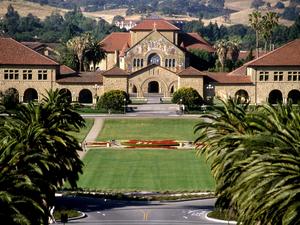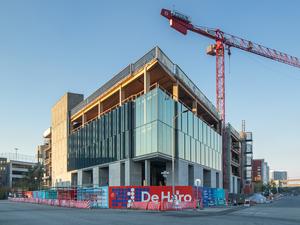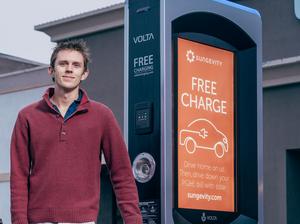It wasn’t that long ago that green technology startups were about as popular in Silicon Valley as a three-piece suit.
After an initial burst of enthusiasm for companies focusing on green, clean and related technologies starting around 2006, venture investors soured on the sector as competition from China undermined their investments in solar, wind and battery startups. For much of the last decade, founders eager to combat global warming were met with a cold shoulder by venture firms.
But things started to change around 2018. That year, national venture investment in the sector hit $8.3 billion, more than double the amount from the prior year and the highest annual total ever to that point, according to PitchBook Data. After two more years of robust investment, things have gone gangbusters.
Already in 2021, venture capitalists have invested $13.4 billion in the sector nationally, which would be a record amount for a full year, according to PitchBook. They’re on track to pour $25 billion into cleantech startups before the year ends, which would be more than they invested in the three prior years combined — and more than they invested in the entire six-year period from 2006 to 2011 that many now refer to as the Cleantech 1.0 era.
Just what has investors so enthused about green and clean startups now that we’ve entered what some call the Cleantech 2.0 era? They’re seeing ways to make money from the technology, said Valerie Shen, a partner and chief operating officer at G2 Venture Partners, also known as G2VP.
“Climate tech now has the possibility of being super profitable,” she said.
Shen and her firm have a unique perspective on the industry. The roots of G2VP stretch back to the early days of the first Cleantech boom, to a Ted Talk that Kleiner Perkins partner John Doerr gave in 2007. In his presentation, Doerr predicted green technologies would be “bigger than the internet” and possibly the “biggest economic opportunity of the 21st century.” His Menlo Park firm bet big, setting up a $500 million fund the following year specifically aimed at cleantech startups and pledging to invest part of a $700 million early-stage fund in such companies.
The bets didn’t pay off as expected. Many Cleantech 1.0 startups were little more than projects with the promise of helping to slow climate change, Shen said. Those companies foundered when China started helping its own green technology companies undercut them. Overall, U.S. venture capitalists lost about half the money they invested in the sector during that first investment wave, according to a report last year from PwC.
In 2017, with cleantech about as far from hot as can be, Kleiner spun off its green investment team, creating Portola Valley-based G2VP. The breakaway firm closed its second, $500 million fund in June. Doerr personally kicked in some of the capital for both G2VP’s first and latest funds.
Although Cleantech 1.0 gets a bad rap, it wasn’t all an investment disaster. Tesla Inc., the poster child of that era, is now the most valuable car maker in the world, with a market capitalization of $680 billion. Solar technology company Enphase Energy Inc. is valued at about $25 billion. Together the two companies, both of which were backed by Kleiner, employ more than 50,000 people.
In some cases, those early bets took a while to pay off. Proterra, for example, was founded right as the first cleantech boom was about to get underway. The Burlingame-based electric bus company, which was backed by G2VP and Kleiner, took years to convince transit agencies to add its vehicles to their fleets. It now has some 650 on the road, grew its sales last year despite the hit transit took from the Covid-19 pandemic and went public in June at a $1.6 billion valuation. It’s now worth $2.6 billion.
“You don’t necessarily have to care about the environment to want these businesses to succeed,” Shen said. “There are people buying Teslas because they are cleaner. But there are also people buying them because it is just a better product.”
Right place, right time
What’s different this time around is that Shen and other venture investors aren’t betting on companies out of some sense of moral obligation or a vague notion of future returns. Instead, they’re investing in companies with proven technologies and ready markets that are starting to scale their businesses.
Take Mainspring Energy Inc. The company got its start at the tail end of Cleantech 1.0 but has really come of age in the latest green tech era.
The Menlo Park startup has developed a new kind of electricity generator — something known as a linear generator — that promises to be cleaner than traditional diesel- or gasoline-powered ones and less expensive to operate than newer fuel-cell ones. Mainspring’s device produces electricity by using natural gas or biogas — or, in the future, hydrogen — to fuel a low-temperature reaction with air to push a pair of large, piston-like oscillators covered with magnets in opposite directions through copper coils.
The company is pitching its generator as a greener producer of electricity in and of itself for use as a backup generator or as the primary power source in so-called microgrids. It’s also pitching it as a complement to intermittent cleantech energy sources like solar cells and wind turbines whose output could ramped up or dialed back as needed.
Mainspring, which has about 200 employees, has shipped its generators to Fortune 500 big-box retail, grocery and utility customers, according to the company. It’s in talks with businesses in the shipping, logistics and telecommunications industries and with operators of 100% biogas wastewater treatment facilities.
The company essentially sprang from a thermodynamics lab in Stanford University, where co-founders Shannon Miller, Matt Svrcek and Adam Simpson prototyped and developed a linear generator. In 2010, when Mainspring had only a handful of workers and a lot left to prove, Khosla Ventures helped jump start it with $2.8 million in funding. Two years later, when the company raised its Series B round, Microsoft founder Bill Gates came on board as an investor.
Mainspring was fortunate that its initial backers were patient, Miller said. “Our early investors, like Bill Gates, were really interested in energy and understood how critical it was to be able produce low-cost and clean power ... They understood how difficult it is to develop hardware, and we were really early at that point.”
The company started to take off just as the venture industry began getting interested in green startups again. In 2018, as it was getting ready to scale up its manufacturing and sales, Mainspring raised $83 million in a Series C round. In July, it closed a $108 million Series D that included backing from Chevron Technology Ventures, the investment arm of the energy giant, and American Electric Power Co.
“These are companies that can help us commercialize and scale,” Miller said.
'The Climate Crisis is not unsolvable'
The coming of age of the clean technology industry and companies like Mainspring has come amid a significant change in the way emerging companies are financed and go public. In the last two years, there has been an explosion in the number of special purpose acquisition companies, or SPACs. Also known as blank-check companies, these entities are basically just investment vehicles that raise money through traditional initial public offerings and use those funds to convince startups to merge with them and go public.
Solving the climate crisis is going to require lots of money — somewhere in the order of $6 trillion by 2030, said Robert Tichio of New York-based Riverstone Holdings, a private equity firm with a focus on energy, power and infrastructure companies. Tichio heads the firm's Menlo Park office and leads its four cleantech-focused SPACs, which are all dubbed some variation of Decarbonization Plus.
The strategy of Riverstone's blank-check companies is to invest in a range of different companies that can together help decouple the economy from climate change-driving carbon usage more quickly, Tichio said.
"The climate crisis is not unsolvable," he said. But, he added, "it requires massive amounts of capital."
Tichio’s SPACs aren’t the only ones in the cleantech game. Some 28 blank-check companies have struck or completed merger deals with green technology or related startups since the beginning of last year, according to a report by Silicon Valley Bank. Those agreements have already or are in the process of funneling $7 billion in cash to those cleantech companies, both from the money the SPACs raised in their IPOs and from the private placement investments that often coincide with the mergers.
Over the next 24 months, SPAC mergers will direct another $35 billion to $40 billion to cleantech companies, according to SVB's projections.
SPACs have begun drawing close scrutiny from regulators due to the projections and promises they've been making about their merger partners that startups generally can't make when they go through traditional IPOs. Blank-check deals have also drawn a growing number of class-action lawsuits thanks to the frequently volatile nature of the stocks of the post-merger companies.
"I know that SPAC has become a four-letter word to some people," Tichio said. "But we think it’s an extraordinarily unique and powerful way to provide solutions to climate change because of the very early stage businesses they tend to support."
Why now?
But investors aren't waiting until companies are ready to go public to get in on Cleantech 2.0. The record amounts of capital venture investors are pouring into green technology startups nationally is mirrored both locally and globally.
So far this year, venture firms and funds have invested $4.5 billion in Bay Area cleantech and related startups, which has already surpassed last year's full-year record amount, according to PitchBook. Venture investors are on track to plow $58 billion into such companies globally by the end of they year, according to a July report from SVB. That would top last year's record level of $35 billion.
“There are orders of magnitude more dollars (that are) being invested at this time than back in Cleantech 1.0,” said Kelly Belcher, managing director of the bank’s energy and resource innovation practice and author of the report.
Transportation and logistics startups have attracted the plurality of investments, raking in about $13.5 billion last year, according to SVB. Ranking No. 2 were agriculture and food startups, which attracted $5.7 billion in funding in 2020. Energy and power startups accounted for about $4.4 billion last year.
The reason so much money is flowing into cleantech these days is simple, Belcher said.
“There is more data that shows the need for climate action now than there was 10 or 15 years ago,” he said. “People are seeing that not only is climate changing but we have ways that can definitely inhibit that change. Public perception is followed by public policy.”
But you don’t have to believe in climate change to get in on the Cleantech 2.0 boom. Case in point: tech founder and entrepreneur T.J. Rodgers. Rodgers has invested in or founded numerous green technology companies. Last month, a SPAC he founded merged with and took public Enovix, a Fremont-based battery developer, in a $1.8 billion deal.
“I reject green religion but I am quite willing to sell you something, if you’re green and religious,” he said. “If you want to buy solar cells, the companies I’m involved with make good ones.”








